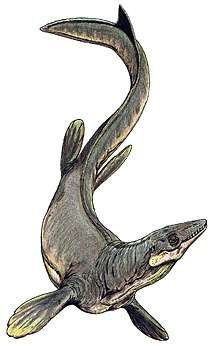Eremiasaurus
Eremiasaurus is a genus of extinct genus of Cretaceous marine lizard belonging to the mosasaur family. It is classified as part of the Mosasaurini tribe (within the Mosasaurinae) and is exclusively known from the Maastrichtian phosphates of the Ouled Abdoun Basin in Morocco. Eremiasaurus means "desert lizard", referring to the arid climate of present-day Morocco where its fossils were recovered.
| Eremiasaurus | |
|---|---|
| Scientific classification | |
| Kingdom: | Animalia |
| Phylum: | Chordata |
| Class: | Reptilia |
| Order: | Squamata |
| Superfamily: | †Mosasauroidea |
| Family: | †Mosasauridae |
| Tribe: | †Mosasaurini |
| Genus: | †Eremiasaurus Leblanc et al., 2012 |
| Type species | |
| †E. heterodontus Leblanc et al., 2012 | |
One species is known, E. heterodontus, whose specific name refers to high degree of heterodonty exhibited compared to other species of mosasaur.
Description

Eremiasaurus is known from two specimens, both designated as syntype specimens. The syntype specimen UALVP 51744 consists of a nearly complete skull, vertebral column and isolated pieces of the appendicular skeleton, whilst the syntype specimen OCP DEK/GE 112 also includes a nearly complete skull as well as a nearly complete vertebral column. Based on observations of these specimens, several distinguishing features can be established that clearly support Eremiasaurus as a distinct genus. The most prominent of these is the high degree of heterodonty and the unusually large number of pygal vertebrae, only Plotosaurus is known to have possessed more pygal vertebrae.[1]
"Liodon" mosasauroides Gaudry, 1892 is apparently a species of Eremiasaurus based on unpublished morphological comparisons reported in an SVP abstract by Mohr et al. (2019).[2]
Classification
An analysis carried out at the time of its description featuring a data matrix of 135 characters and 32 terminal taxa recovered Eremiasaurus heterodontus as a sister taxon to the Plotosaurini, a tribe now seen as synonymous with the Mosasaurini. A close relation to (or even inclusion within) the Mosasaurini is supported by the presence of an internarial bar keel, the exclusion of the prefrontals from the narial borders, narial embayments in the frontal and the presence of a quadrate ala groove.[1]
Eremiasaurus differs from the closely related Mosasaurus and Plotosaurus in having the infrastapedial and suprastapedial processes of the quadrate fused, possessing a very large and rounded stapedial pit, large pterygoid teeth and the glenoid condyle of the humerus being gently domed.
Cladogram of Eremiasaurus and related taxa within the Mosasaurinae modified from D.V. Grigoriev, 2013:[3]
| Mosasaurinae |
| |||||||||||||||||||||||||||||||||||||||||||||||||||||||||||||||||||||||||||||||||||||||||||||||||||
References
- Leblanc, A.R.H.; Caldwell, M.W.; Bardet, N. (2012). "A new mosasaurine from the Maastrichtian (Upper Cretaceous) phosphates of Morocco and its implications for mosasaurine systematics". Journal of Vertebrate Paleontology. 32 (1): 82–104. doi:10.1080/02724634.2012.624145.
- Mohr, LeBlanc, Caldwell, 2019. REDESCRIPTION AND REASSIGNMENT OF “LIODON” MOSASAUROIDES TO THE GENUS EREMIASAURUS (SQUAMATA, MOSASAURIDAE). SVP 2019, Annual Meeting, Program and Abstracts, 79A: 155.
- Grigoriev, D. V. (2013). Redescription of Prognathodon lutugini (Squamata, Mosasauridae). Proceedings of the Zoological Institute RAS, 317(3): 246-261.
